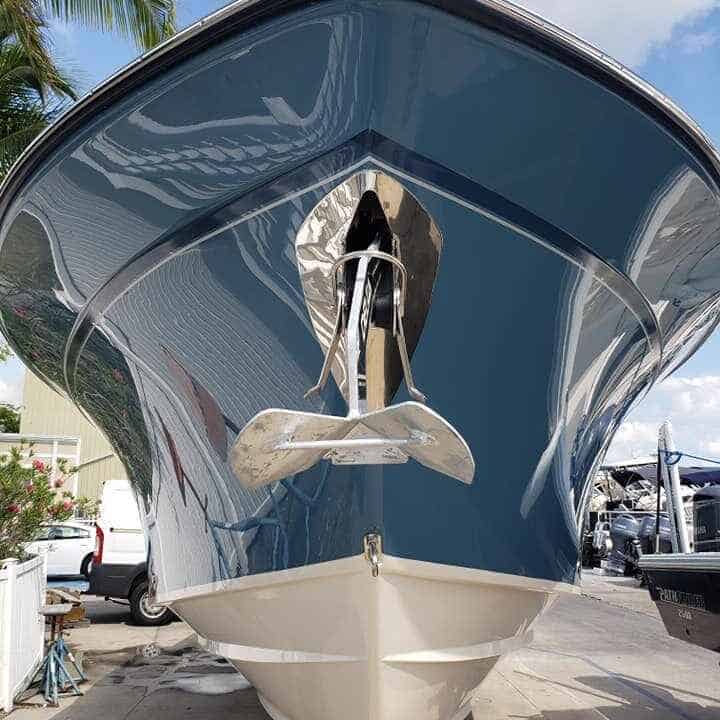Table of Contents
Introduction to Ceramic Coating for Boats
Ceramic coatings have revolutionized the way we protect our vessels from the harsh marine environment. This invisible shield not only adds a lustrous sheen to a boat’s exterior but also offers an impressive array of protective benefits. At its core, it is a liquid polymer that bonds with the surface, creating a durable layer of protection. Herein, you’ll be able to understand how to apply ceramic coating for boats.
Definition of Ceramic Coating for Boats
Imagine an extra skin for your boat, one that fights off UV rays, saltwater, and grime. That’s what ceramic coating does. It’s a chemically engineered product designed to bond with the gel coat or paint of your boat. Once cured, it forms a hard, protective layer that stands guard against various elements.
Importance and Benefits of Applying Ceramic Coating for Boats
Boat owners are turning to ceramic coatings for boats for good reason. The ceramic coating for boats acts as a strong barrier against sun damage, oxidation, and corrosion. It simplifies maintenance, as dirt and salt are less likely to stick, making cleaning a breeze. Plus, it enhances the boat’s appearance, giving it a lasting shine that makes waves in terms of aesthetics.Stepping into the practical guide on how to apply ceramic coating to your boat, it’s crucial first to highlight the process and preparation involved. Ceramic coatings require a clean, smooth surface for optimal adhesion. So, let’s dive into the step-by-step instructions that ensure your investment in this cutting-edge technology pays off when applying ceramic coating for boats.
Preparation Stage of Applying Ceramic Coating for Boats
- Clean Your Boat Thoroughly Before Applying Ceramic Coating for Boats: The initial step involves the thorough cleaning of your boat’s surface. It’s not just about removing visible dirt or stains; it’s about achieving a deep clean. Use a high-quality boat soap and possibly a clay bar to remove any contaminants that regular washing won’t eliminate.
- Fix Any Surface Imperfections Before Applying Ceramic Coating for Boats: Inspect the surface for scratches, dings, or oxidized areas. These imperfections should be dealt with prior to applying the ceramic coating. Depending on the severity, wet sanding, polishing, or professional repair may be necessary. This step ensures a perfectly smooth surface that will allow the ceramic coating to bond effectively and evenly.
- Final Cleaning Before Applying Ceramic Coating for Boats: Once you’ve addressed the surface imperfections, a final cleaning is required to remove any dust or residue from the repair and smoothing process.
Steps to Apply Ceramic Coating to Boats
Step 1: Clean and Prep the Boat Surface for Ceramic Coating for Boats
Preparation is key when applying ceramic coating for boats. A pristine surface ensures that the ceramic coating adheres properly and performs at its best. Starting with a thorough clean is crucial.
Remove Contaminants Before Applying Ceramic Coating for Boats
Begin by removing any contaminants from the surface before applying ceramic coating for boats. This includes algae, barnacles, and other marine buildup. A clean hull is essential for a successful application.
Wash and Dry Thoroughly Before Applying Ceramic Coating for Boats
Next, wash the boat with a high-quality cleaner before applying ceramic coating for boats. After washing, drying thoroughly is just as important to prevent trapping moisture under the coating.
Mask Off Areas Before Applying Ceramic Coating for Boats
Use masking tape to protect areas that you don’t want the coating to cover. This includes hardware and non-painted surfaces. Precise masking leads to clean lines and professional results.
Step 2: Apply the Ceramic Coating for Boats
With the surface prepped, it’s time to apply the ceramic coating for boats. This is where transformation happens.
Choose the Right Ceramic Coating Product Before Applying Ceramic Coating for Boats
Selecting the right ceramic coating for boats product is essential. Look for marine-specific options that cater to the unique challenges boats face.
Apply Evenly and in Sections
Application should be even and methodical when applying ceramic coating for boats. Work in small sections, using a microfiber applicator to spread the coating evenly.
Allow Sufficient Curing Time
Patience is a virtue here. Allow the coating to cure as per the manufacturer’s instructions. This ensures maximum durability and effectiveness.
Step 3: Buff and Polish While Applying Ceramic Coating for Boats
Once the coating has cured, the next step is to bring out the shine. Buffing and polishing not only enhance the boat’s look but also strengthen the protective layer.
Remove Excess Coating
If there’s excess coating, now is the time to remove it. Using a clean microfiber cloth, gently buff the surface until it’s smooth.
Polish for Shine and Protection
Polishing not only adds a glossy finish but also removes any residual haze from the curing process, ensuring the coating’s protective qualities are evenly distributed.
Inspect for Uniformity
A final inspection is crucial. Ensure that the coating is uniform and free of streaks or spots for optimal protection and appearance.
Step 4: Final Touches and Maintenance for Ceramic Coating for Boats
The final step focuses on ensuring the longevity of your ceramic coating through proper maintenance.
Remove Masking After Applying Ceramic Coating for Boats
Carefully remove all the masking tape. This reveals the precision of your application work and ensures a clean, sharp look.and avoids any unwanted coating on protected areas. The removal should be done gently to avoid disrupting the freshly applied ceramic layer.
Conduct a Detailed Inspection After removing the masking tape, conduct a thorough inspection of the boat’s surface. Look for any missed spots, uneven areas, or imperfections in the coating. Addressing these early ensures the longevity and aesthetics of the ceramic coat.
Implement Regular Maintenance Maintaining the ceramic coating is critical for its durability. Regular washing with pH-neutral soap will remove contaminants without damaging the coating. Avoid harsh chemicals or abrasive tools that can compromise the integrity of the ceramic layer.
Apply Top-up Coats as Needed Over time, the ceramic coating may wear down in high-use or exposed areas. Applying top-up coats can help maintain the protective and aesthetic benefits. Follow the manufacturer’s recommendations regarding the frequency and application process for these maintenance coats.
Educate on Proper Care Practices Finally, educating yourself or others who will be handling the boat on proper care practices can greatly extend the life of the ceramic coating.
Inspect for Any Imperfections After Applying Ceramic Coating for Boats
A meticulous inspection allows you to catch any imperfections. Address these promptly to maintain the integrity of the coating.and ensure a consistently high-quality finish. It’s worth investing the time to periodically inspect the boat’s surface, not only after the initial application but also as part of the ongoing maintenance routine. Catching and addressing imperfections early can prevent them from becoming more significant issues that are harder to correct.
Document Your Process Keeping a record of the ceramic coating process, including dates of application, products used, and any specific techniques employed, can be incredibly beneficial. This documentation will help you track the coating’s longevity and effectiveness over time. Additionally, it provides valuable information when applying top-up coats or if you need to communicate with the product manufacturer for advice or warranty purposes.
Use Protective Gear during Maintenance When applying ceramic coatings or performing maintenance tasks, it’s crucial to wear appropriate protective gear. This includes gloves and masks, especially if you’re working with chemicals or performing tasks that generate dust or fumes. Protecting yourself from potential harm is just as important as protecting the boat’s surface.
Seek Professional Advice When Necessary While many boat owners may feel comfortable applying a ceramic coating themselves, there may be times when consulting with or hiring a professional is advantageous.
Provide Guidelines for Ongoing Maintenance After Applying Ceramic Coating for Boats
To extend the life of the ceramic coating, adhere to recommended maintenance routines. This includes regular washing and applying booster products if necessary.
Conclusion for Applying Ceramic Coating for Boats
The journey to protect and beautify your boat with ceramic coating is both an art and a science. With the right approach, materials, and maintenance, your boat can enjoy unparalleled protection and a magnificent shine for years to come.
FAQs
What are some boat coatings that repel water?
Boat hulls are regularly subjected to various environments and need to be coated with products that effectively repel water to enhance performance and longevity. There are several types of coatings used to achieve this repellent effect.
- Antifouling paints: They are specialized coatings applied to the underwater part of boats to slow the growth of subaquatic organisms that can affect the boat’s performance and durability. Some antifouling paints contain biocides like copper compounds, while others are biocide-free and rely on their physical properties to repel organisms.
- Epoxy sealers: These coatings are often used on wooden boats to create a waterproof barrier that prevents water infiltration. Epoxy sealers penetrate wood grains and cure to form a hard, water-resistant surface.
- Silicone coatings: Silicones provide a slippery, low friction surface that can reduce drag and repel water and other substances.
- Ceramic coatings: Nano-ceramic coatings are increasingly used for their hydrophobic (water repellent) and protective qualities. Their nanoscale structure can create a surface that water droplets cannot easily adhere to, thereby providing self-cleaning properties as water washes away contaminants.
- Polyurethane and acrylic coatings: These finishes are known for their durability and excellent water-repelling abilities. They are used not only for their protective properties but also for aesthetic purposes, as they can enhance the shine and color of the boat’s hull.
Each of these coatings offers unique benefits and potential drawbacks related to application process, lifetime, environmental impact, and cost. The selection of a specific coating often depends on the boat’s material, expected usage, and the local marine conditions.
How durable is ceramic coating?
Ceramic coatings, applied as a protective layer over a substrate such as metal, paint, or polymer, leverage the inherent properties of ceramics—namely, their chemical inertness and high resistance to wear and abrasion—to enhance surface durability. The durability of a ceramic coating is influenced by several factors, including the thickness of the coating, the quality of its application, the composition of the ceramic material used, and the conditions to which the coated item is exposed.
In the automotive industry, for example, ceramic coatings are popular for their ability to protect paint from environmental contaminants, UV light exposure, and light scratches. A well-applied high-quality ceramic coating on a car can last anywhere from two to five years, depending on how the vehicle is used, maintained, and stored. Coatings exposed to harsher conditions such as road salts, acidic bird droppings, or abrasive cleaning techniques will naturally degrade faster than those maintained with gentle washing and kept in milder environments.
In other industries, too, the specific composition of ceramic coatings can affect their performance. Some coatings are designed for high-temperature environments, such as exhaust coatings in aerospace applications, where they may maintain their properties at temperatures exceeding 1000°C. Others might be formulated for electrical insulation or for use in biomedical implants where they must resist body fluids and stress over extended periods.
It’s important to consider that while ceramic coatings are durable, they are not indestructible. They’re subject to the usual laws of physics and chemistry. Mechanical forces exceeding their material limits, harsh chemicals, and extreme thermal shocks can all compromise the integrity of the coating.
Therefore, to answer how durable ceramic coatings are, one must assess the expected level of exposure to abrasive forces, chemicals, temperature variations, and UV light, as well as the specifics of the ceramic formulation and the aptness of the application process for the use case in question.
What is the typical lifespan of a ceramic coating?
Ceramic coatings are a chemical polymer solution that is applied to the exterior of a vehicle to protect it from external paint damage. Typically applied by hand, it blends with the paint of your car and creates an additional hydrophobic layer of protection. The longevity of a ceramic coating depends on a variety of factors including the quality of the materials, the application method, and the environment to which the car is exposed.
High-quality ceramic coatings, when properly applied, are advertised to last anywhere from 2 to 5 years, with some premium coatings claiming to offer protection for up to 10 years or more under ideal conditions. The lifespan can be shorter if the vehicle undergoes harsh conditions regularly, such as exposure to extreme temperatures, mechanical abrasion, or corrosive substances. Moreover, the care and maintenance of the coating are crucial; regular washing and occasional application of a booster product can extend its life.
Regular ceramic coatings are different from ceramic sealants or wax, which have a much shorter life expectancy, often in the range of a few months. The key to maximizing the efficacy and lifespan of a ceramic coating is to follow the manufacturer’s guidelines for application and maintenance.
Therefore, while the phrase “typical lifespan” of a ceramic coating can be somewhat broad due to these factors, a general ballpark figure is in the range of 2 to 5 years, with variations depending on usage, maintenance, and environmental exposure.
Do you wax before or after ceramic coating?
When it comes to vehicle detailing, waxing and applying a ceramic coating are two methods used to protect a car’s paint and enhance its shine. It’s important to understand that wax and ceramic coatings serve similar purposes but are fundamentally different products. Wax, traditionally a combination of carnauba and other waxes, provides a protective layer with a rich gloss but doesn’t last as long as ceramic coatings. Ceramic coatings, on the other hand, consist of a chemical polymer solution that bonds with the paint and forms a long-lasting protective layer.
The process of applying a ceramic coating requires that the surface be as clean and decontaminated as possible to ensure proper bonding and the maximum durability of the protective coat. This often involves thorough washing, clay barring to remove surface contaminants, polishing to remove any defects or swirls, and finally a surface cleanser or IPA wipe to remove any residual oils or products.
Given that the objective is to create a strong bond between the paint and the ceramic coating, applying wax before a ceramic coating would be counterproductive. The wax would prevent the ceramic coating from bonding effectively with the paint, significantly reducing the longevity and effectiveness of the ceramic coating.
Therefore, if you are planning to apply a ceramic coating, it should be done on a completely clean and decontaminated surface, which has not been waxed. After a ceramic coating has been applied, and the proper curing time has passed, there is generally no need to wax the car, as the ceramic coating provides more durable protection and gloss than wax can offer. Some products are designed to be applied on top of ceramic coatings to enhance gloss or hydrophobic properties, but these are not traditional waxes. It is important to follow the instructions of the specific coating manufacturer, as they may have developed maintenance products that are compatible with their coatings.
Is applying a ceramic coat outdoors in a sunny day a hard no?
Applying a ceramic coating to a vehicle’s surface is a task that requires controlled conditions to ensure the best results. Ceramic coatings are advanced chemical polymers that bond with a vehicle’s paint at a molecular level, providing a long-lasting and durable layer of protection. The process of application and the environment in which it takes place can significantly affect the quality of the seal and ultimately the level of protection and aesthetic finish.
Outdoor application, particularly on a sunny day, can introduce a few challenges. Firstly, direct sunlight can rapidly increase the surface temperature of the vehicle’s paint. Ceramic coatings usually require a certain temperature range for application, typically between 50 to 70 degrees Fahrenheit. If the surface is too hot, the coating may cure too quickly, leading to streaks or an uneven finish that detracts from the glossy appearance and can compromise the level of protection. This can also make the application process more difficult, as the installer will have less working time to level and bond the coating properly.
Secondly, environmental contaminants like dust, pollen, or insects can adhere to the wet ceramic coating before it cures, resulting in imperfections in the finish. Wind can bring these contaminants to the coated surface even if they aren’t immediately apparent in the environment.
In conclusion, applying a ceramic coat outdoors on a sunny day often entails such risks that can compromise the result. While not necessarily a “hard no,” it is typically advised against due to the increased likelihood of problems arising during the application process. Optimally, a controlled indoor environment is the preferred setting for this task, ensuring the temperature stays in the appropriate range and environmental contaminants are minimized.












